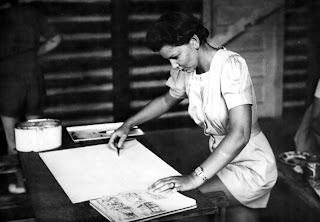“Woman’s College Trying New Experiment On Coast,” reported the Greensboro Daily News in June of 1938. Beginning in the early 1930s, the North Carolina College for Women (now UNC Greensboro) offered a course in marine science for a select group of students. Each summer, students applied to attend the course in Beaufort, North Carolina. Students were tasked with arranging their own room and board for the duration of the course and were able to get practical experience in the field of marine biology. The program developed into an annual opportunity for students desiring a hands-on approach to their education in a course that would now be described as experiential learning. (To read more about the Marine Biology Summer Session, please click here.)
The ‘new experiment’ in the summer of 1938 entailed the creation of a similar summer program available for students wishing to study art. Young women were offered the opportunity to study advanced landscape painting at the coast.
Professor Gregory Ivy, head of the Art Department of Woman’s College, had searched for an ideal site to establish this summer ‘colony’ of art students. Beaufort had been recommended to him as a suitable location and easily won him over upon his first visit to the town. Aside from the scenic landscapes all around, he also found an optimal indoor space to serve as shelter on a rainy day or as a lecture hall. Beaufort was home to one of the largest structures built of logs in the country, its community center. The local Chamber of Commerce allowed Ivy to use a large room in the community center that, with its beautiful light, served as an excellent art studio and lecture hall for the summer program.
The first course in the summer of 1938, attended by around 30 students, provided the chance to earn four hours of college credit and incorporated the concepts and techniques used by the Post-Impressionists, Cubists, and Surrealists, all modern art movements of the late 19th and early 20th century, and no doubt a draw for the young artists of Woman’s College. The program was open to students of other southern schools and colleges as well as to teachers interested in the experience.
In its second year, the summer art program offered the same landscape painting class as well as a general advanced painting class. Participants, some studying to become professional artists and others considered themselves hobbyists, began using an old mansion house in town as their dormitory. Though plans were made to eventually build a dormitory for the summer program, it never came to fruition.
Aside from the additional course offered the second year, the first annual Beaufort art exhibition took place, jointly sponsored by the Chamber of Commerce and Professor Ivy. Local artists as well as out-of-state artists were invited to participate, and it was billed as the first exhibition of its kind in a southern coastal town.
One can only imagine the idyllic setting of Beaufort in the late thirties and early forties for the Woman’s College art students. Hilda Brady, a junior at Woman’s College during the summer of 1939 described it as “the land of the jasmine because of the great abundance of these fragrant flowers, a spray of which was placed beside the plate of guests each morning.” In all likelihood, such treats for the senses were available in abundance for the young women who spent the majority of the year in land-locked Greensboro.
The effects of World War II unfortunately put a damper on the Beaufort Art Colony, which was shuttered for the last three summers of the war, 1943-1945. The art colony reopened in 1946 and art courses were expanded to include design, figure drawing, and art education in addition to the watercolor class taught by Dr. Ivy. The Colony also began to include music in the course offerings. By the mid-fifties, the “Fine Arts” summer session of Woman’s College included dance, theater, and creative writing.
In the late forties and early fifties, the Fine Arts summer program, focused mostly on theater, was held in western North Carolina in the mountains near Burnsville (for more information about the Burnsville School of Fine Arts, please click here). It returned to Beaufort by 1954, sixteen years after it began. Aside from a broad selection of fine arts courses available to college students that year, classes for school-aged children were introduced, and the Beaufort Chamber of Commerce began providing two scholarships, one for adults and one for children to attend the program. The Woman’s College Library provided library facilities and a trained librarian during the summer session as well.
Professor Gregory Ivy, founder of the Beaufort Art Colony, left the Woman’s College in 1961. It is clear the Beaufort Art Colony continued into the mid-fifties, but there is no specific mention of it in University Bulletins after 1954. Since the Colony was the brainchild of Ivy, it is likely that it ended with his tenure at the University. In his resignation letter, he expressed his frustration at the college’s lack of funding for the Art Department. His legacy at the Woman’s College extends well beyond the Beaufort Art Colony. To read more about Ivy, please visit “Gregory Ivy: The Legacy of a Non-Conformist”. Professor Ivy was the driving force behind developing the Woman’s College art program. His idea to start the Beaufort Art Colony was just one of many contributions to art education at what is now UNC Greensboro.
Ivy’s legacy lives on in the thriving UNC Greensboro School of Art, which boasts both undergraduate and graduate degree programs, a nationally and internationally renowned faculty of practicing artists, and an incredibly motivated, talented student body.
By Suzanne Helms




